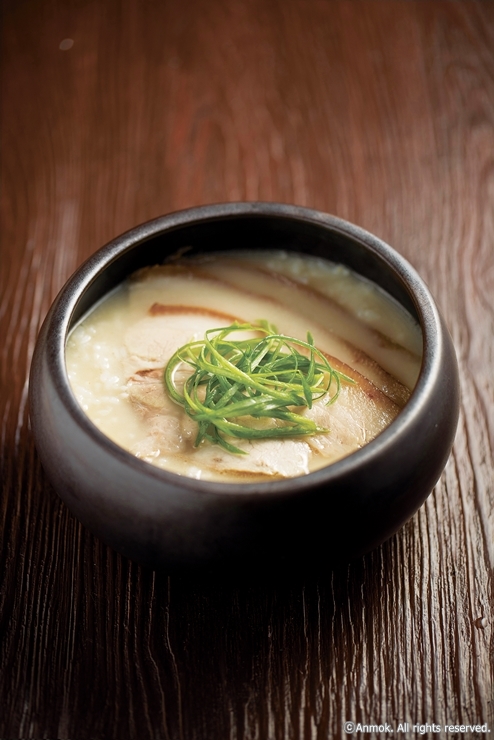Food
A bowl of soup that mirrors its hometown history



Unique bowls of dwaeji gukbap are found citywide.
(top to bottom, 1. Anmok's soup does not require extra seasoning. 2. Namakzip's soup is light and nourishing. 3. Hapcheon Gukbapjip serves generous portions of meat.)
In February, the Michelin Guide rated Busan restaurants for the first time. The city's 43 Michelin-recommended restaurants range from homestyle eateries to luxurious fine dining. Three places achieved rarefied star status: French spot Palate, Italian bistro Fiotto, and Japanese restaurant Mori each earned one star.
In addition, Michelin rated 15 Busan establishments as Bib Gourmand, meaning they offer good food at moderate prices.
With so many dining options, deciding where to eat can be a Paradox of Choice. Luckily, Busan is Good is here to ease your restaurant anxiety. Follow our recommendations and every meal can be one to remember.
Traditional dish, modern sensibility
Do not trust a Busan food guide if it doesn't include an ode to "dwaeji gukbap," generous bowls of pork soup and rice that power the city's denizens. Born from the privation of war, dwaeji gukbap is not merely a hearty soup; it is a culinary symbol of Korea's modern history, of refugees fleeing violence, of survival during a war that tore the country in two.
Such lofty meaning granted to a humble meal of pork, soup and rice may seem excessive, but for many Busanites, dwaeji gukbap is a reminder that no matter how hard life gets, comfort is just a bowl away. Plus, it is really, really good.
Traditionally, dwaeji gukbap features a milky-white, rich stock. However, the versions Michelin recommends are lighter and cleaner, reflecting Korea's current food culture. Just as Busan is undergoing modernization, so too is its representative dish.
□ Clear soup at Hapcheon Gukbapjip (Bib Gourmand selection)
Hapcheon Gukbapjip serves dwaeji gukbap rooted in tradition and full of time-tested flavors. However, its soup has evolved with changing times and dietary trends.
Here, the pork is repeatedly covered with broth and drained before it is served. This technique eliminates impurities and unpleasant odors while preserving the meat's rich flavor. Instead of milky-white stock, the meat sits in a pool of clear broth. Diners dive right in, delighting in the clean and light soup.
The umami created by the luscious pork, savory soup and tender rice grains reverberates in the mind long after empty bowls clang upon tables.
Diners also enjoy Hapcheon Gukbapjip's signature slices of boiled pork. Portions are limited, so arrive early. Solo eaters should avoid lunch.
•Address: 235 Yongho-ro, Nam-gu
•Hours: 9:30 a.m. to 8 p.m. Break time from 2 to 2:30 p.m.
•Price: ₩10,000 for gukbap, ₩35,000 for boiled pork slices
□Defying expectations at Anmok (安木) (Bib Gourmand selection)
For many people, eating dwaeji gukbap is a Proustian experience, with each bowl evoking warm memories of post-drinking camaraderie.
Not at Anmok, however.
Anmok's unconventional take on dwaeji gukbap defies any memories one might have of the dish. Diners seeking the greasy, unctuous flavors traditionally desired in pork-centric meals will be happily disappointed. The chefs at Anmok have done the impossible by creating a rich soup full of pork flavor without any greasiness. This magic is also displayed in servings of sliced pork, as each piece has a nice layer of meat and fat without a hint of grease.
Despite its status as a supporting character, the rice at Anmok is hardly an afterthought. Each grain stays al dente even when submerged in the soup, providing a pleasing chew to contrast the succulent meat.
Anmok also offers servings of pork ramen reminiscent of Japanese tonkotsu ramen.
•Address: 3 Gwangnam-ro 22 beon-gil, 101ho, Suyeong-gu
•Hours: 11:30 a.m. to 9 p.m. Break time from 3 to 5 p.m. Closed on Wednesdays.
•Price: ₩9,000 for gukbap, ₩9,000 for ramen
□Vegetable-forward soup at Namakzip (Selected Restaurant)
Michelin rates some establishments as "selected," which denotes restaurants that serve high-quality meals but not at star or Bib level. Busan boasts 25 Selected Restaurants.
One such restaurant is Namakzip, which serves a unique take on dwaeji gukbap, right down to the serving ware. Traditionally, dwaeji gukbap is served in dark, heavy earthenware bowls that jump straight from the fire to the table. In contrast, Namakzip serves its version in a delicate, white ceramic lidded bowl, a stark visual distinction that previews the soup inside.
Under the lid lies sliced pork and handfuls of finely chopped chives mounted in a very light broth. Namakzip states its broth is 90% vegetable-based, which results in a soup that tastes light and clean rather than heavy and rich. While this version is clearly a derivative of the Busan staple, it is different enough that the restaurant calls it "dwaeji gomtang." In Korean cuisine, gomtang refers to soups made by boiling meat only, without bones.
In addition, the menu includes "kalguksu," or soup and hand-cut noodles, and grilled pork belly.
•Address: #1068 A, W Square, 145 Bunpo-ro, Nam-gu
•Hours: 11:30 a.m. to 9 p.m. Break time from 3 to 5 p.m.
•Price: ₩9,000 for dwaeji gomtang, ₩8,000 for kalguksu
Vocab Spotlight
nourishing: 영양가 있는
moderate: 보통의, 적당한
denizens: 거주자
lofty: 고상한
excessive: 과도한
impurities: 불순물
odor: 냄새
umami: 감칠맛
luscious: 감미로운
reverberate: 울려 퍼지다
Defy: 저항하다, 거역하다
Proustian experience: 프루스트 경험(후각의 경험을 매개로 해서 마음 깊은 곳에서 웅크려 잠자고 있는 기억을 깨어나게 해서 지금 이 순간 떠오르게 만드는 현상)
unctuous: 불쾌한
submerged: 잠긴
earthenware: 토기
lidded bowl: 뚜껑이 있는 그릇

